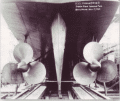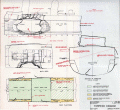Click On Image
For Full Size Image |
Size |
Image Description |
Contributed
By |

| 72k | James Hooker Strong was born in Canandaigua, NY on 26 April 1814. On February 2, 1829, while a student in the Polytechnic College at Chittenango, NY, he was appointed a Midshipman in the United States Navy. He made his first cruise on the Brazil station in Lexington from 1833 to 1835. After various cruises, he commanded the store ship Relief in 1859. Strong was promoted to Commander in April 1861 and commanded Mohawk and Flag in the South Atlantic Blockading Squadron in 1861 and 1862, and Monongahela in the West Gulf Blockading Squadron from1863 to 1865. At the Battle of Mobile Bay, he was the first to ram the Confederate ironclad Tennessee and received high commendation for his initiative and valor. Strong served at the Brooklyn Navy Yard in 1866 and 1867 and later commanded Canandaigua in the Mediterranean Squadron in 1869 and 1870. He was promoted to Rear Admiral in Sept. 1873 and served as Commander-in-Chief of the South Atlantic Squadron from 1873 to 1875. The U.S.S. Strong (DD467) was the first U.S. Naval Vessel to bear the name of Admiral Strong. | Bill Gonyo |

| 57k | Undated, location unknown. | - |

| 102k | Stern view looking forward of USS Strong's (DD-467) twin screws and rudder. Photo taken on christening day, 17 May 1942, at the Bath Iron Works Yard, Bath, Maine. National Archives and Records Administration. | Robert Hurst |

| 95k | USS Strong (DD-467) heavily retouched copy of a photograph taken circa the later part of 1942. The retouching, which includes the land in the distance and the ship from the forward smokestack to the top of the pilothouse, was mainly done for censorship purposes, in order to eliminate radar antennas from the ship's gun director and foremast. Official U.S. Navy Photograph, from the collections of the Naval Historical Center. | Fred Weiss |

| 100k | Ships of Task Force 18 during gunnery exercises off Espiritu Santo, New Hebrides, on 19 April 1943. At right are the destroyers Strong (DD-467) and O'Bannon (DD-450), making a turn. The three large ships in the distance are light cruisers, including St. Louis (CL-49) and Helena (CL-50) at left and either Nashville (CL-43) or Honolulu (CL-48) in the right center. Official U.S. Navy Photograph, now in the collections of the National Archives. Photo #: 80-G-299058. | Robert Hurst |

| 109k | USS Strong (DD-467) highlines mail to USS Honolulu (CL-48) during operations in the Solomon Islands area, circa early July 1943. Strong was torpedoed and sunk off New Georgia on 5 July 1943. Note the sign painted on Honolulu's starboard catapult: "No Smoking Abaft This Sign". Official U.S. Navy Photograph, now in the collections of the National Archives. | Fred Weiss |

| 155k | USS Strong (DD-467) highlines mail to USS Honolulu (CL-48) during operations in the Solomon Islands area, circa early July 1943. Strong was torpedoed and sunk off New Georgia on July 5, 1943. Note the sign painted on Honolulu's starboard catapult: No Smoking Abaft This Sign. Source: United States National Archives, Photo No. 80-G-52931. | Mike Green |

| 359k | United States Naval Department Bureau of Ships War Torpedo Damage/Loss Report No. 50. USS Strong (DD-467). Destroyer torpedo damage and loss on July 5, 1943 at Kula Gulf. | Mike Green |

| 295k | The wreckage of Strong (DD-467) was discovered 300 meters below the waters of Kula Gulf by Paul G. Allen's R/V Petrel on 06 February 2019. This photo shows Strong's No. 1 5" gun mount. Photo courtesy of Paul G. Allenís Vucan Inc. | John Slaughter |

| 310k | This photo shows Strong's port side propeller. Photo courtesy of Paul G. Allenís Vucan Inc. | John Slaughter |


 46 of her crew were lost with the ship and remain on duty.
46 of her crew were lost with the ship and remain on duty.